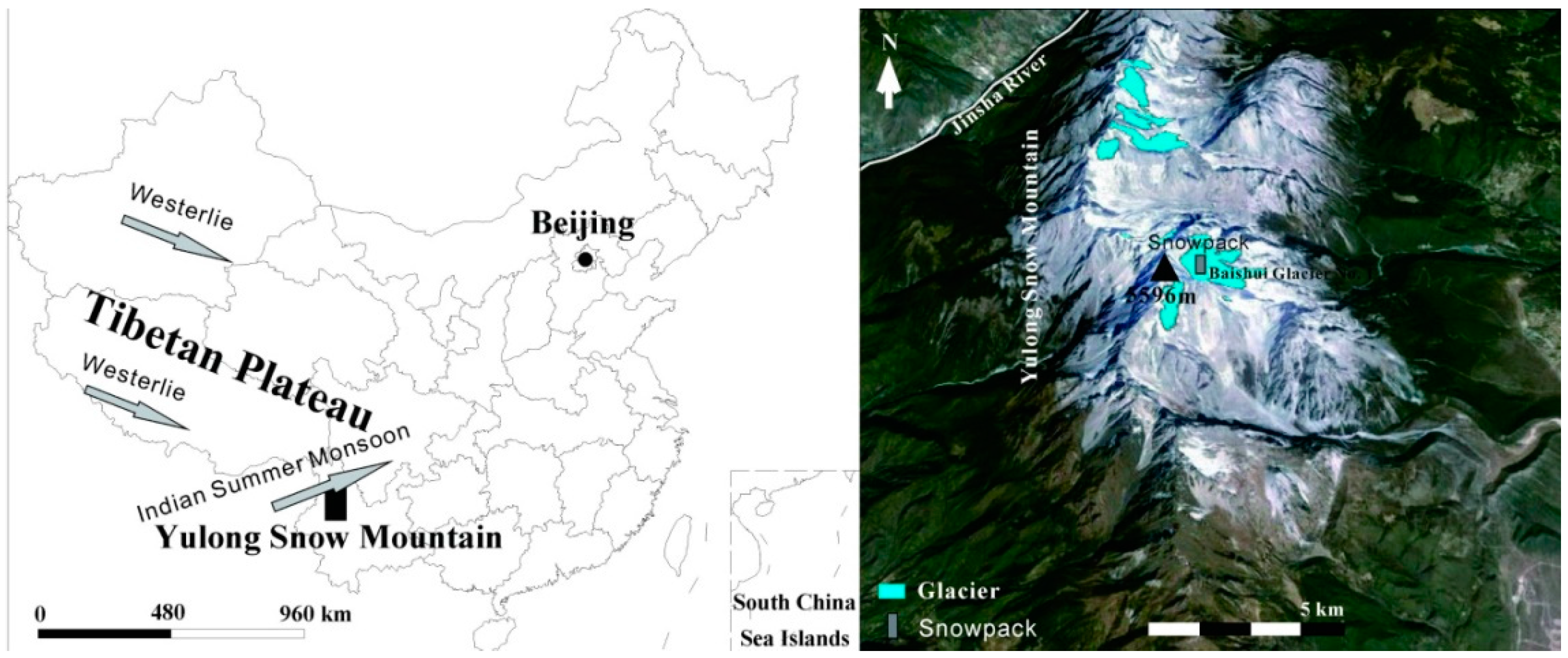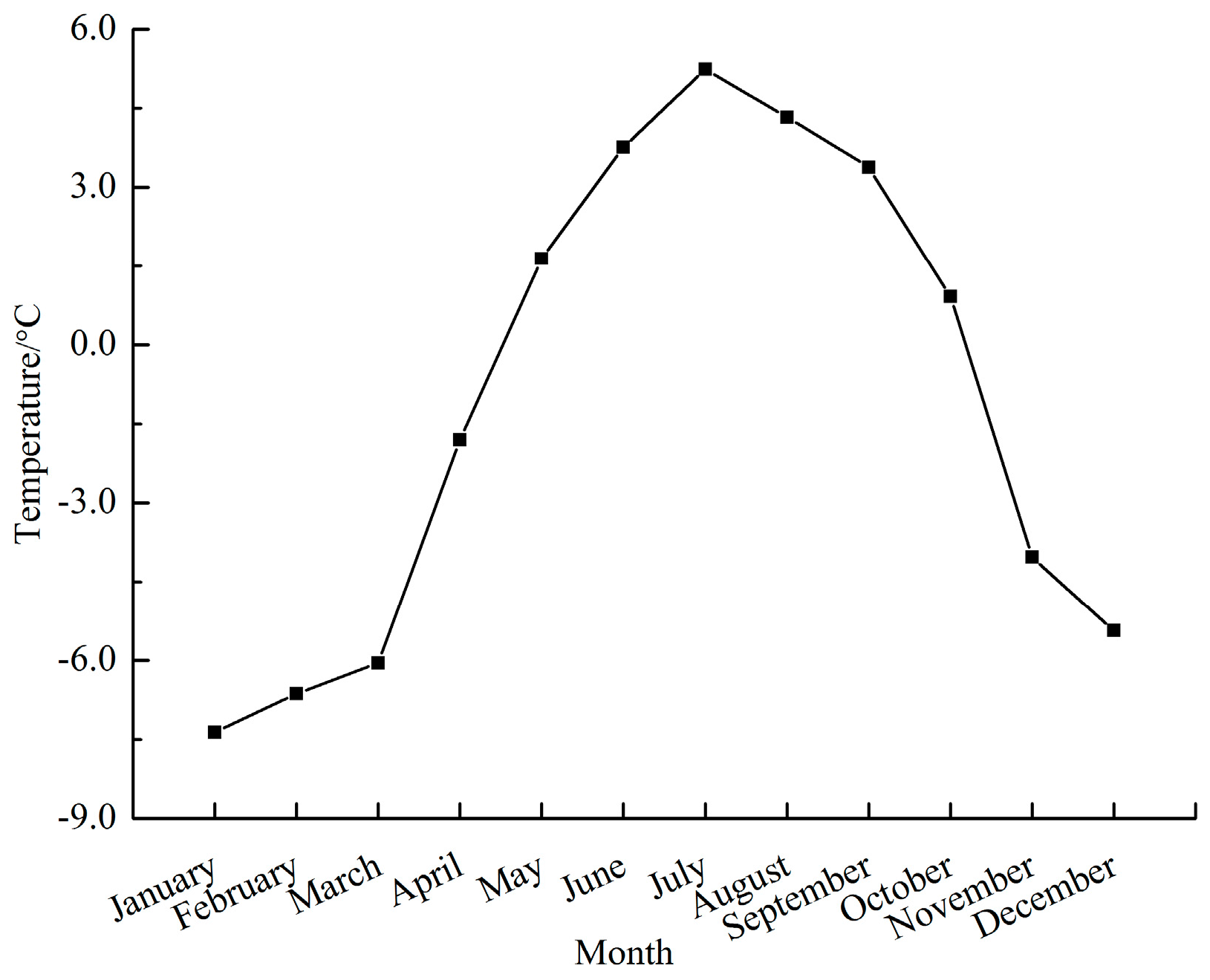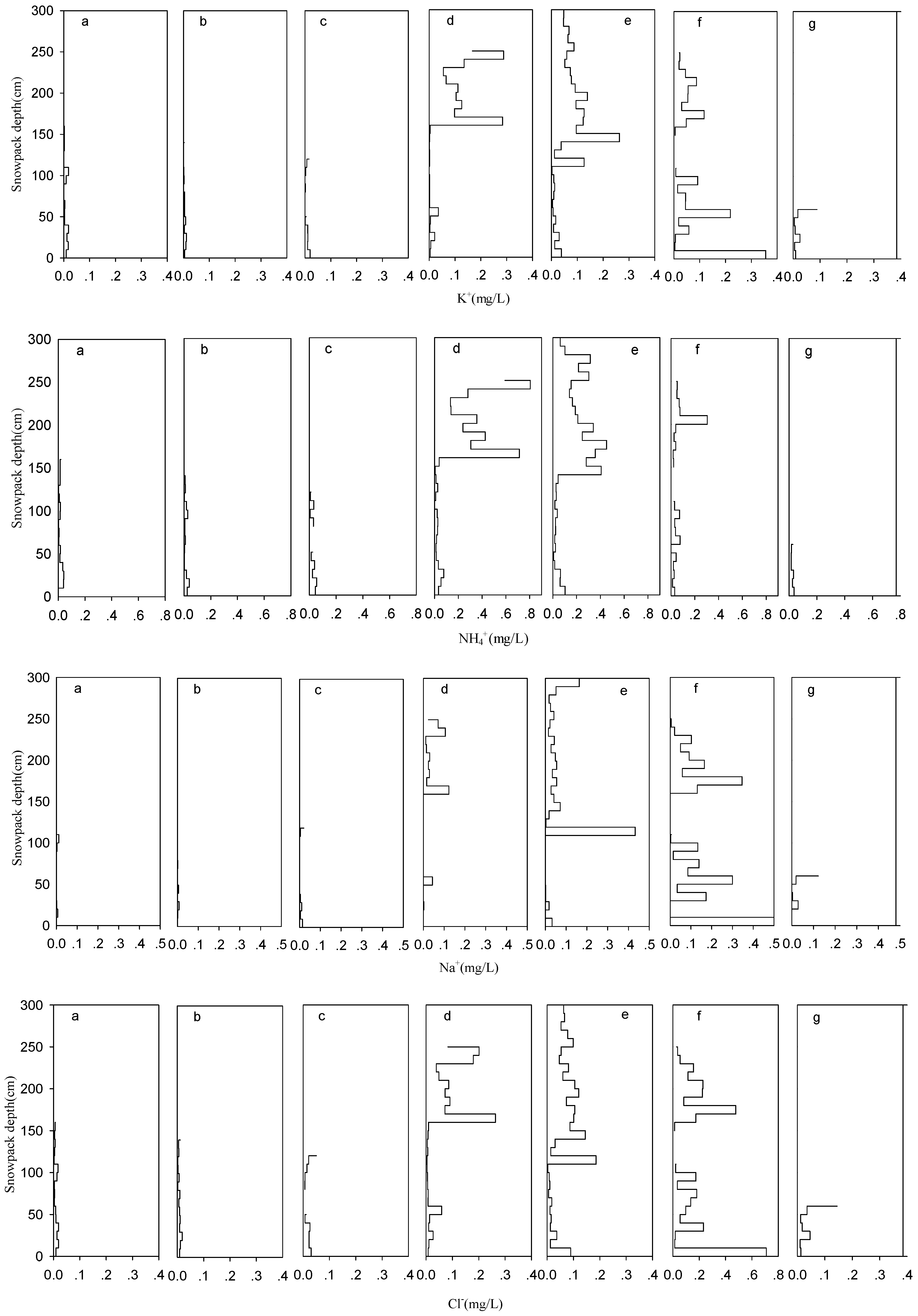Seasonal Variability and Evolution of Glaciochemistry at An Alpine Temperate Glacier on the Southeastern Tibetan Plateau
Abstract
:1. Introduction
2. Study Area
3. Materials and Methods
4. Results and Discussion
4.1. Chemical Composition of Snowpack Samples
4.2. Elution Process
4.3. Ion Source
4.4. Environmental Significance of Chemical Ions in Snowpack
5. Conclusions
Acknowledgments
Author Contributions
Conflicts of Interest
References
- Taylor, S.; Feng, X.H.; Kirchner, J.W.; Osterhuber, R.; Klaue, B.; Renshaw, C.E. Isotopic evolution of a seasonal snowpack and its melt. Water Resour. Res. 2001, 37, 759–769. [Google Scholar] [CrossRef]
- Turk, J.T.; Taylor, H.E.; Ingersoll, G.P.; Tonnessen, K.A.; Clow, D.W.; Mast, M.A.; Campbell, D.H.; Melack, J.M. Major-ion chemistry of the Rocky Mountain snowpack, USA. Atmos. Environ. 2001, 35, 3957–3966. [Google Scholar] [CrossRef]
- Moran, T.; Marshall, S. The effects of meltwater percolation on the seasonal isotopic signals in an Arctic snowpack. J. Glaciol. 2009, 55, 1012–1024. [Google Scholar] [CrossRef]
- Wolff, E.W. Signals of atmospheric pollution in polar snow and ice. Antarct. Sci. 1990, 2, 189–205. [Google Scholar] [CrossRef]
- Wake, C.P.; Mayewski, P.A.; Zheng, L.; Han, J.; Qin, D.W. Modern eolian dust deposition in Central Asia. Tellus Ser. B Chem. Phys. Meteorol. 1994, 46B, 220–233. [Google Scholar] [CrossRef]
- Legrand, M.; Mayewski, P. Glaciochemistry of polar ice cores: A review. Rev. Geophys. 1997, 35, 219–243. [Google Scholar] [CrossRef]
- Xiao, C.; Qin, D.W.; Ren, J.F. Glaciochemistry distribution in the surface snow/ice in some key regions of the cryosphere: The environmental significance (in Chinese). J. Glaciol. Geocryol. 2002, 24, 492–499. [Google Scholar]
- Kang, S.C.; Qin, D.H.; Mayewski, P.A.; Sneed, S.B.; Yao, T.D. Chemical composition of fresh snow on Xixabangma peak, central Himalaya, during the summer monsoon season. J. Glaciol. 2002, 48, 337–339. [Google Scholar] [CrossRef]
- Aizen, V.B.; Aizen, E.M.; Melack, J.M.; Kreutz, K.J.; Cecil, D.W. Association between atmospheric circulation patterns and firn-ice core records from the Inilchek glacierized area, central Tien Shan, Asia. J. Geophys. Res. Atmos. 2004, 109, 657–678. [Google Scholar] [CrossRef]
- Brimblecombe, P.; Tranter, M.; Abrahams, P.W.; Blackwood, I.; Davies, T.D.; Vincent, C.E. Relocation and preferential elution of acidic solute through the snowpack of a small, remote, high-altitude Scottish catchment. Ann. Glaciol. 1985, 7, 141–147. [Google Scholar] [CrossRef]
- Hou, S.G.; Qin, D.H.; Zhang, D.Q.; Kang, S.C.; Mayewski, P.A.; Wake, C.P. A 154 a high-resolution ammonium record from the Rongbuk Glacier, north slope of Mt. Qomolangma (Everest), Tibet-Himal region. Atmos. Environ. 2003, 37, 721–729. [Google Scholar]
- Heuer, K.; Tonnessen, K.A.; Ingersoll, G.P. Comparison of precipitation chemistry in the Central Rocky Mountains, Colorado, USA. Atmos. Environ. 2000, 34, 1713–1722. [Google Scholar] [CrossRef]
- Lafrenière, M.J.; Sinclair, K.E. Snowpack and precipitation chemistry at a high altitude site in the Canadian rocky mountains. J. Hydrol. 2011, 409, 737–748. [Google Scholar] [CrossRef]
- Koerner, R.M.; Fisher, D.A. A record of holocene summer climate from a Canadian high-arctic ice core. Nature 1990, 343, 630–631. [Google Scholar] [CrossRef]
- Kang, S.C.; Mayewski, P.A.; Qin, D.H.; Sneed, S.A.; Ren, J.W.; Zhang, D.Q. Seasonal differences in snow chemistry from the vicinity of Mt. Everest, central Himalayas. Atmos. Environ. 2004, 38, 2819–2829. [Google Scholar] [CrossRef]
- Zhang, N.N.; He, Y.Q.; Cao, J.J.; Ho, K.F.; Shen, Z.X. Long-term trends in chemical composition of precipitation at Lijiang, southeast Tibetan Plateau, southwestern China. Atmos. Res. 2012, 106, 50–60. [Google Scholar] [CrossRef]
- Niu, H.W.; He, Y.Q.; Zhu, G.F.; Xin, H.J.; Du, J.K.; Pu, T.; Lu, X.X.; Zhao, G.Y. Environmental implications of the snow chemistry from Mt. Yulong, southeastern Tibetan Plateau. Quat. Int. 2013, 313–314, 168–178. [Google Scholar] [CrossRef]
- Dong, Z.W.; Qin, D.H.; Ren, J.W.; Qin, X.; Xu, J.Z.; Sun, W.J. Characteristics of atmospheric dust deposition in snow on the glaciers of western Qilian Mountains. Acta Geogr. Sin. 2013, 68, 25–35. (In Chinese) [Google Scholar]
- Li, Z.X.; Feng, Q.; Guo, X.Y.; Gao, Y.; Pan, Y.H.; Wang, T.T.; Li, J.G.; Guo, R.; Jia, B.; Song, Y.X.; et al. The evolution and environmental significance of glaciochemistry during the ablation period in the north of Tibetan Plateau, China. Quat. Int. 2014, 374, 93–109. [Google Scholar]
- Ingersoll, G.P.; Mast, M.A.; Campbell, D.H.; Clow, D.W.; Nanus, L.; Turk, J.T. Trends in snowpack chemistry and comparison to national atmospheric deposition program results for the Rocky Mountains, US, 1993–2004. Atmos. Environ. 2008, 42, 6098–6113. [Google Scholar] [CrossRef]
- Dong, Z.W.; Li, Z.Q.; Xiao, C.D.; Wang, F.T.; Zhang, M.J. Characteristics of aerosol dust in fresh snow in the Asian dust and non-dust periods at Urumqi Glacier No. 1 of eastern Tian Shan, China. Environ. Ear. Sci. 2010, 60, 1361–1368. [Google Scholar] [CrossRef]
- He, Y.Q.; Zhang, Z.L.; Theakstone, W.H.; Chen, T.; Yao, T.D.; Pang, H.X. Changing features of the climate and glaciers in China’s monsoonal temperate glacier region. J. Geophys. Res. Atmos. 2003, 108, 550–558. [Google Scholar] [CrossRef]
- Pang, H.X.; He, Y.Q.; Hou, S.G.; Zhang, N.N. Changes in ionic and oxygen isotopic composition of the snow-firn pack at Baishui Glacier No. 1, southeastern Tibetan Plateau. Environ. Earth Sci. 2012, 67, 2345–2358. [Google Scholar] [CrossRef]
- Zhu, G.F.; Pu, T.; He, Y.Q.; Shi, P.J.; Zhang, T. Seasonal variations of major ions in fresh snow at Baishui Glacier No. 1, Yulong Mountain, China. Environ. Earth Sci. 2013, 69, 1–10. [Google Scholar] [CrossRef]
- He, Y.Q.; Yao, T.D.; Cheng, G.D.; Yang, M.X. Climatic records in a firn core from an alpine temperate glacier on Mt. Yulong, southeastern part of the Tibetan Plateau. Episodes 2001, 24, 13–18. [Google Scholar]
- Pang, H.X.; He, Y.Q.; Theakstone, W.H.; Zhang, D. Soluble ionic and oxygen isotopic compositions of a shallow firn profile, Baishui Glacier No. 1, southeastern Tibetan Plateau. Ann. Glaciol. 2007, 46, 325–330. [Google Scholar] [CrossRef]
- Li, Z.X.; He, Y.Q.; Pang, H.X.; Jia, W.X.; He, X.H.; Zhang, N.N.; Ning, B.Y.; Yuan, L.L.; Song, B.; Theakstone, W.H. Chemistry of snow deposited during the summer monsoon and in the winter season at Baishui Glacier No. 1, Yulong Mountain, China. J. Glaciol. 2009, 55, 221–228. [Google Scholar] [CrossRef]
- Wang, S.J.; Du, J.K.; He, Y.Q. Spatial-temporal characteristics of a temperate-glacier’s active-layer temperature and its responses to climate change: A case study of Baishui Glacier No. 1, southeastern Tibetan Plateau. J. Earth Sci. 2014, 25, 727–734. [Google Scholar] [CrossRef]
- Wang, S.J.; Cao, W.H. Climate change perspectives in an alpine area, southwest China: A case analysis of local residents’ views. Ecol. Indic. 2015, 53, 211–219. [Google Scholar] [CrossRef]
- Pu, T.; Qin, D.H.; Kang, S.C.; Niu, H.W.; He, Y.Q.; Wang, S.J. Water isotopes and hydrograph separation in different glacial catchments in the southeast margin of the Tibetan Plateau. Hydrol. Process. 2017. [Google Scholar] [CrossRef]
- Li, Z.Q.; Edwards, R.; Mosley-Thompson, E.; Wang, F.T.; Dong, Z.B.; You, X.N.; Li, H.L.; Li, C.J.; Zhu, Y.M. Seasonal variability of ionic concentrations in surface snow and elution processes in snow–firn packs at the PGPI site on Ürümqi Glacier No. 1, eastern Tien Shan, China. Ann. Glaciol. 2006, 43, 250–256. [Google Scholar] [CrossRef]
- Geng, Z.X.; Hou, S.G.; Zhang, D.Q.; Kang, S.C.; Wang, Y.T.; Liu, Y.P. Major ions in ice cores and snowpits from the himalayas: Temporal and spatial variations and their sources. J. Glaciol. Geocryol. 2007, 29, 191–200. [Google Scholar]
- Kang, S.C.; Wake, C.P.; Qin, D.H.; Mayewski, P.A.; Yao, T.D. Monsoon and dust signals recorded in Dasuopu Glacier, Tibetan Plateau. J. Glaciol. 2000, 46, 222–226. [Google Scholar]
- Huang, C.L.; Yao, T.D.; Pu, J.C.; Duan, K.Q.; Wang, N.L.; Tian, L.D. Environmental information recorded in shallow ice core of Dasuopu Glacier in the Qinghai-Tibetan Plateau. Sci. Bull. 1998, 43, 1935–1936. [Google Scholar] [CrossRef]
- Kang, S.C.; Mayewski, P.A.; Qin, D.W.; Yan, Y.; Hou, S.G.; Zhang, D.; Ren, J.W.; Kruetz, K. Glaciochemical records from a Mt. Everest ice core: Relationship to atmospheric circulation over Asia. Atmos. Environ. 2002, 36, 3351–3361. [Google Scholar] [CrossRef]
- Schott, F.A.; Peter, B.; Meike, H.; Jürgen, F.; Lothar, S. Observations of the preferential loss of major ions from melting snow and laboratory ice. Water Res. 1987, 21, 1279–1286. [Google Scholar]
- Tranter, M.; Tsiouris, S.; Davies, T.D.; Jones, H.G. A laboratory investigation of the leaching of solute from snowpack by rainfall. Hydrol. Process. 1992, 6, 169–178. [Google Scholar] [CrossRef]
- Eichler, A.; Schwikowski, M.; Gäggeler, H.W. Meltwater-induced relocation of chemical species in alpine firn. Tellus Ser. B Chem. Phys. Meteorol. 2001, 53, 192–203. [Google Scholar] [CrossRef]
- Hewitt, A.D.; Cragin, J.H.; Colbeck, S.C. Does snow have ion chromatographic properties. In Proceedings of the 46th Annual Eastern Snow Conference, Quebec City, QC, Canada, 8–9 June 1989; pp. 165–171. [Google Scholar]
- Zhao, Z.P.; Li, Z.Q.; Edwards, R.; Wang, F.T.; Li, H.L.; Zhu, Y.M. Atmosphere to snow to firn transfer of NO3− on Ürümqi Glacier No. 1, eastern Tien Shan, China. Ann. Glaciol. 2006, 43, 239–244. [Google Scholar] [CrossRef]
- Li, X.Y.; Li, Z.Q.; Ding, Y.J.; Liu, S.Y.; Zhao, Z.P.; Liang, L.; Pang, H.X.; Li, C.J.; Li, H.L.; You, X.N.; et al. Seasonal variations of pH and electrical conductivity in a snow-firn pack on Glacier No. 1, eastern Tianshan, China. Cold Reg. Sci. Technol. 2007, 48, 55–63. [Google Scholar] [CrossRef]
- Kuhn, M.; Haslhofer, J.; Nickus, U.; Schellander, H. Seasonal development of ion concentration in a high alpine snow pack. Atmos. Environ. 1998, 32, 4041–4051. [Google Scholar] [CrossRef]
- He, Y.Q.; Pang, H.X.; Theakstone, W.H.; Zhang, D.; Lu, A.G.; Song, B.; Yuan, L.L.; Ning, B.Y. Spatial and temporal variations of oxygen isotopes in snowpacks and glacial runoff in different types of glacial area in western China. Ann. Glaciol. 2006, 43, 269–274. [Google Scholar] [CrossRef]
- He, Y.Q. Isotopic, Ionic and Physical Studies of Snow and Firn at the Glacier Austre Okstindbreen, Okstinnadn, Norway, in Relation to Local Climatic Variations and to Regional Atmospheric Circulations. Ph.D. Thesis, University of Manchester, Manchester, UK, 1992. [Google Scholar]





| Month | November | December | January | March | April | June | July | |
|---|---|---|---|---|---|---|---|---|
| N. | 17 | 15 | 11 | 26 | 31 | 27 | 7 | |
| Depth (cm) | 158 | 140 | 120 | 250 | 302 | 262 | 64 | |
| pH | 6.27 | 6.91 | 6.51 | 6.69 | 6.88 | 6.49 | 6.51 | |
| EC | 3.39 | 3.15 | 8.07 | 11.05 | 11.61 | 6.19 | 3.52 | |
| Cl− | Mean | 0.01 | 0.01 | 0.02 | 0.05 | 0.06 | 0.14 | 0.04 |
| Dev. | 0.01 | 0.01 | 0.01 | 0.07 | 0.05 | 0.16 | 0.05 | |
| NO3− | Mean | 0.05 | 0.04 | 0.06 | 0.38 | 0.33 | 0.09 | 0.05 |
| Dev. | 0.07 | 0.03 | 0.05 | 0.53 | 0.30 | 0.12 | 0.03 | |
| SO42− | Mean | 0.06 | 0.04 | 0.09 | 0.80 | 0.71 | 0.15 | 0.06 |
| Dev. | 0.07 | 0.04 | 0.06 | 1.05 | 0.70 | 0.24 | 0.02 | |
| Na+ | Mean | 0.00 | 0.00 | 0.00 | 0.02 | 0.04 | 0.11 | 0.02 |
| Dev. | 0.00 | 0.00 | 0.01 | 0.03 | 0.08 | 0.17 | 0.04 | |
| NH4+ | Mean | 0.01 | 0.01 | 0.03 | 0.17 | 0.15 | 0.05 | 0.03 |
| Dev. | 0.01 | 0.01 | 0.02 | 0.23 | 0.13 | 0.06 | 0.01 | |
| K+ | Mean | 0.01 | 0.00 | 0.01 | 0.06 | 0.06 | 0.06 | 0.02 |
| Dev. | 0.01 | 0.00 | 0.01 | 0.09 | 0.06 | 0.08 | 0.03 | |
| Mg2+ | Mean | 0.03 | 0.03 | 0.08 | 0.08 | 0.06 | 0.04 | 0.05 |
| Dev. | 0.05 | 0.05 | 0.09 | 0.09 | 0.06 | 0.05 | 0.04 | |
| Ca2+ | Mean | 0.45 | 0.44 | 1.53 | 2.08 | 2.06 | 0.80 | 0.45 |
| Dev. | 0.79 | 0.64 | 2.20 | 2.39 | 2.11 | 1.17 | 0.23 | |
| Ions | Cl− | NO3− | SO42− | Na+ | NH4+ | K+ | Mg2+ | Ca2+ |
|---|---|---|---|---|---|---|---|---|
| Cl− | 1 | |||||||
| NO3− | 0.210 | 1 | ||||||
| SO42− | 0.207 | 1.000 ** | 1 | |||||
| Na+ | 0.991 ** | 0.131 | 0.130 | 1 | ||||
| NH4+ | 0.290 | 0.993 ** | 0.993 ** | 0.207 | 1 | |||
| K+ | 0.770 * | 0.777 * | 0.776 * | 0.715 | 0.823 * | 1 | ||
| Mg2+ | −0.007 | 0.582 | 0.583 | 0.127 | 0.618 | 0.362 | 1 | |
| Ca2+ | 0.140 | 0.873 * | 0.878 ** | 0.050 | 0.883 ** | 0.642 | 0.832 * | 1 |
| Ions | Factor | ||
|---|---|---|---|
| 1 | 2 | 3 | |
| Cl− | 0.627 | 0.723 | 0.100 |
| NO3− | 0.905 | −0.307 | −0.137 |
| SO42− | 0.888 | −0.311 | −0.226 |
| Na+ | 0.424 | 0.877 | 0.136 |
| NH4+ | 0.882 | −0.276 | −0.288 |
| K+ | 0.905 | 0.315 | −0.047 |
| Mg2+ | 0.734 | −0.248 | 0.485 |
| Ca2+ | 0.716 | −0.357 | 0.493 |
| Variance % | 57.604 | 21.010 | 8.704 |
© 2018 by the authors. Licensee MDPI, Basel, Switzerland. This article is an open access article distributed under the terms and conditions of the Creative Commons Attribution (CC BY) license (http://creativecommons.org/licenses/by/4.0/).
Share and Cite
Wang, S.; Shi, X.; Cao, W.; Pu, T. Seasonal Variability and Evolution of Glaciochemistry at An Alpine Temperate Glacier on the Southeastern Tibetan Plateau. Water 2018, 10, 114. https://doi.org/10.3390/w10020114
Wang S, Shi X, Cao W, Pu T. Seasonal Variability and Evolution of Glaciochemistry at An Alpine Temperate Glacier on the Southeastern Tibetan Plateau. Water. 2018; 10(2):114. https://doi.org/10.3390/w10020114
Chicago/Turabian StyleWang, Shijin, Xiaoyi Shi, Weihong Cao, and Tao Pu. 2018. "Seasonal Variability and Evolution of Glaciochemistry at An Alpine Temperate Glacier on the Southeastern Tibetan Plateau" Water 10, no. 2: 114. https://doi.org/10.3390/w10020114





